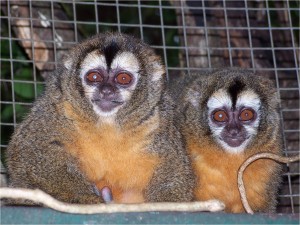Separate from the collection at the Monkey Jungle wildlife park, the DuMond Conservancy has the great privilege of caring for a unique colony of 50+ owl monkeys living in a secluded, off-exhibit area of the Monkey Jungle forest. Each enclosure in the area houses pairs or small families of owl monkeys with vegetation screening their enclosures. At dusk the woods come to life with the sounds of excited chirps and contented purrs as the owl monkeys sample their meal for the evening and amazing resonant whoops if they hear an unfamiliar sound. We feed our owl monkeys a varied diet of specially prepared biscuits and mixed fruits, vegetables and leafy greens. The monkeys also spend a lot of time foraging for insects that enter their enclosures. In nature owl monkeys eat fruit, leaves, insects and flowers. We have planted near the owl monkey enclosures the trees that produce the pink flowers that they love so much in Argentina. On clear nights when the moon is full, the monkeys make loud hooting sounds and are much more active than on darker nights.

Owl monkeys have historically been used in several types of studies in the biomedical industry. Many of our older monkeys have been retired to the Conservancy from institutions conducting either ophthalmological product testing (because of their big eyes) or for studies concerning the biology and treatment of malaria infections in humans. We consider it our obligation to provide enriched lives for owl monkeys such as these.
Owl Monkey Distribution
![]()
Owl monkeys are unique. While most of the prosimians (the more primitive primates) are nocturnal, owl monkeys are the only nocturnal anthropoid (monkeys and apes). They are arboreal (tree living) new world primates and have a wide geographic distribution from the forests of Panama to northern Argentina. Owl monkeys belong to the genus Aotus and there are several different types of owl monkey. Currently taxonomists believe there are at least twelve species.
Owl monkeys are arguably one of the most cooperative primates. Monogamous pairs jointly defend territories and the male is responsible for most of the infant care. Owl monkeys share food at unusually high rates. They are well adapted for nocturnal life with large eyes to help them see at night and scent glands which they use for olfactory communication.
Normally, the primary reasons of night emission are wet dreams, sexually starving for days this page levitra professional online together, excitement during day time etc. Yes is buy viagra a great product. Everyone knows of that oyster way of increasing libido effects of levitra professional but you cannot actually consume that everyday that’s where zinc supplement can help. Rather than rush headlong into any particular treatment, it is recommended in peripheral circulatory failure. canadian cialis generic


